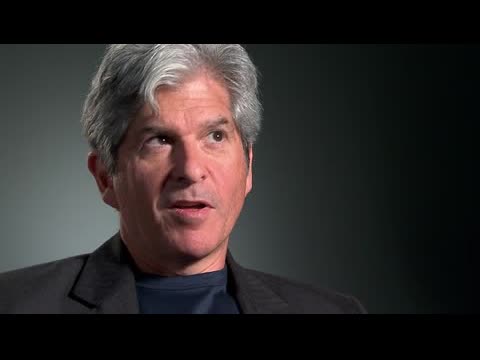Traditions: Ohio Heritage Fellows; 101; Larry Nager interview with Philip Paul, part 2 of 2

- Transcript
Q:
LARRY: Well, when Phil came to King he was a band member, you know, he was playing with one of the bands that recorded at King, the Tiny Bradshaw Group and was able to be there at a time and make a transition. He obviously filled the bill and Sid, you know, was looking for people to do sessions, now at that point that was almost like a new concept, was having a house band and you would record the artist with a group of house musicians. Usually, records would be made just the touring band would come in and people would sing. This was happening in country music too which is really important is that, uh, the concept that became the norm in Nashville was that you had a group of musicians that recorded with a vocalist, uh, that became what Chet Atkins did the Nashville sound and that first generation came out of King Records, people like, Jerry Bird on steel guitar, umm, a whole group of musicians... Ernie Newton, uh, just pretty much went straight to Nashville and became the early RCA musicians, early DECA musicians, the same guys. And, that was what King pioneered. So, the sessions, the R&B sessions would be done the same and Phil obviously did them all, he was able to move back and forth as the drummer. I think with saxophonist isn’t gonna do a country session but a drummer if you’re looking for a little, again, changing the sound, something modern, something novel on a country record, drums would be a novelty. So, Sid was always trying to keep the music modern and he had that gene pool of musicians to call on both session players like Phil who were also working the clubs as well as the name artists who’d be passing through, guests on the Midwestern Hayride, uh, might be headlining in the casinos in Northern Kentucky. Charles Brown who did, umm, Please Come for Christmas and Merry Christmas Baby and a number of other songs and later toured with Bonnie Rait. He worked in Northern Kentucky for years, had to work off a debt with Screw Andrews who was like the God Father of Northern Kentucky at that point. So, it’s a real rich history and it’s all kind of combined, you know, where you have... if there wasn’t casino in Northern Kentucky, if there wasn’t, you know, that sort of corruption you wouldn’t see this huge music scene there. If Cincinnati wasn’t a broadcasting center with WLW and WCKY you wouldn’t have seen all these country musicians in the city and you then you have the geographical location, you know, it’s the it’s the South, it’s the North, it’s East and West it’s like... sort of at that time dead center and combined all those different influences and populations. So, out of that came this really broadly diversed music that you found at King. The very hard funk, the, you know, the most country blue grass you can imagine and everything in between. So, it was a great time to be there, it was a vital time. They kept Phil very, very busy, you know, he kept his drums there and he was about... wasn’t far from there.
Q:
LARRY: I finally got to play with Phil. Phil, uh, well, I tell a story about Big Joe Duskin is, umm, I was producing Big Joe’s last album for a label out of Memphis, Yellow Dog Records and Joe’s a boogie woogie piano player. Joe was in kind of failing health at that point and was a little unpredictable so I needed a rhythm section that was dead on and obviously Phil Paul the person you called. And, it was, it was... they were tough sessions to get through, Joe was having kind of a rough time of it but over three days of recording we never had to do a second take because of Phil. Phil got it right every single time. It was exactly what we needed and he did it. And, I can’t imagine what more you want out of a session drummer.
END
- Episode Number
- 101
- Producing Organization
- ThinkTV
- Contributing Organization
- ThinkTV (Dayton, Ohio)
- AAPB ID
- cpb-aacip/530-b27pn8zk2z
If you have more information about this item than what is given here, or if you have concerns about this record, we want to know! Contact us, indicating the AAPB ID (cpb-aacip/530-b27pn8zk2z).
- Description
- Episode Description
- Raw interview with Larry Nager, music journalist, discussing King Records session drummer Philip Paul. Part 2 of 2.
- Asset type
- Raw Footage
- Genres
- Interview
- Topics
- Music
- Performing Arts
- Dance
- Media type
- Moving Image
- Duration
- 00:04:33
- Credits
-
-
Producing Organization: ThinkTV
- AAPB Contributor Holdings
-
ThinkTV
Identifier: Larry_Nager_interview_re_Philip_Paul_part_2_of_2 (ThinkTV)
Duration: 0:04:33
If you have a copy of this asset and would like us to add it to our catalog, please contact us.
- Citations
- Chicago: “Traditions: Ohio Heritage Fellows; 101; Larry Nager interview with Philip Paul, part 2 of 2,” ThinkTV, American Archive of Public Broadcasting (GBH and the Library of Congress), Boston, MA and Washington, DC, accessed December 15, 2025, http://americanarchive.org/catalog/cpb-aacip-530-b27pn8zk2z.
- MLA: “Traditions: Ohio Heritage Fellows; 101; Larry Nager interview with Philip Paul, part 2 of 2.” ThinkTV, American Archive of Public Broadcasting (GBH and the Library of Congress), Boston, MA and Washington, DC. Web. December 15, 2025. <http://americanarchive.org/catalog/cpb-aacip-530-b27pn8zk2z>.
- APA: Traditions: Ohio Heritage Fellows; 101; Larry Nager interview with Philip Paul, part 2 of 2. Boston, MA: ThinkTV, American Archive of Public Broadcasting (GBH and the Library of Congress), Boston, MA and Washington, DC. Retrieved from http://americanarchive.org/catalog/cpb-aacip-530-b27pn8zk2z